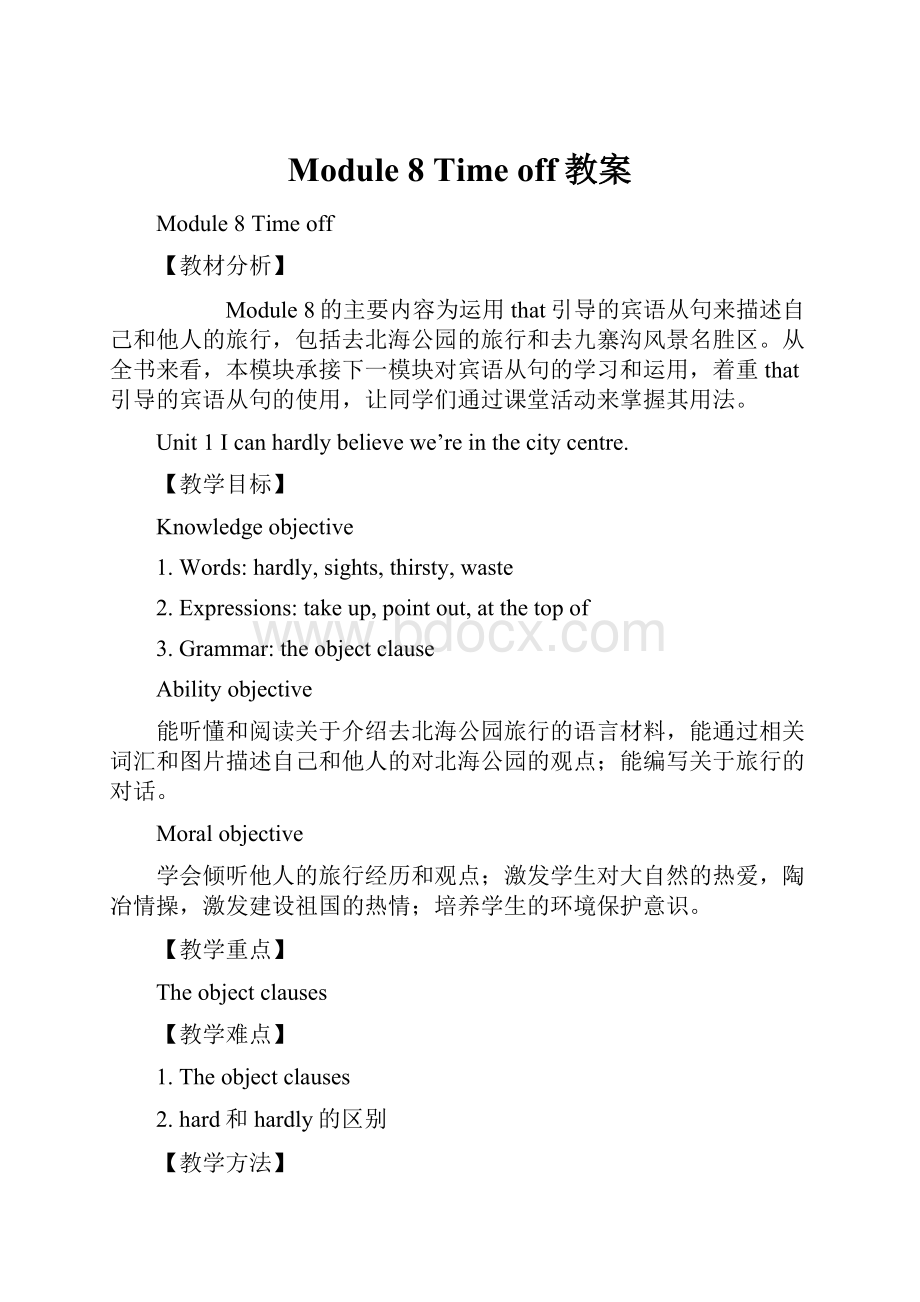Module 8 Time off教案.docx
《Module 8 Time off教案.docx》由会员分享,可在线阅读,更多相关《Module 8 Time off教案.docx(19页珍藏版)》请在冰豆网上搜索。

Module8Timeoff教案
Module8Timeoff
【教材分析】
Module8的主要内容为运用that引导的宾语从句来描述自己和他人的旅行,包括去北海公园的旅行和去九寨沟风景名胜区。
从全书来看,本模块承接下一模块对宾语从句的学习和运用,着重that引导的宾语从句的使用,让同学们通过课堂活动来掌握其用法。
Unit1Icanhardlybelievewe’reinthecitycentre.
【教学目标】
Knowledgeobjective
1.Words:
hardly,sights,thirsty,waste
2.Expressions:
takeup,pointout,atthetopof
3.Grammar:
theobjectclause
Abilityobjective
能听懂和阅读关于介绍去北海公园旅行的语言材料,能通过相关词汇和图片描述自己和他人的对北海公园的观点;能编写关于旅行的对话。
Moralobjective
学会倾听他人的旅行经历和观点;激发学生对大自然的热爱,陶冶情操,激发建设祖国的热情;培养学生的环境保护意识。
【教学重点】
Theobjectclauses
【教学难点】
1.Theobjectclauses
2.hard和hardly的区别
【教学方法】
PWPmethod,task-basedmethodandinteractiveapproach
【教学手段】
Ataperecorder,multimediaandsomepictures
【教学过程】
TeachingProcedures:
Step1Warmingup
1.AskSstotellsomethingaboutBeihaiPark.
2.SslookanddescribethepicturesofBeihaiPark.
Step2Listening
1.LookatthephotoandlistentoPart1.
Whatistheconversationabout?
2.Listenagainandchoosethecorrectanswer.
Step3Reading
1.Learnsomenewwordsandphrase.
Showthepicturesofnewwordsandletthestudentstosayasquicklyaspossible.
2.ListentoPart3andanswerthefollowingquestions.
1)WhoisintroducingBeihaiPark?
2)Whyaretheythere?
3.ReadthedialogueandmarkTorF.
4.CompletethesentencesaboutBeihaiPark.
Step4Languagepoints
SsshouldmasterthemainpointsfromthepassageinPart3.
1.It’ssoquietherethatIcanevenhearthebirdssinging!
这里安静得我甚至能听见鸟叫的声音。
so…that引导结果状语从句,意为“如此……,以至于……”。
e.g.IwassotiredthatIsleptinthischair. 我太累了,在椅子上睡着了。
2.Icanhardlybelievewe’reinthecitycentre.
我几乎不敢相信我们是在市中心。
hardlyadv.几乎不,几乎没
e.g.Icanhardlyfinishtheworkinaday.我不可能一天内完成这项工作。
hard adv.努力
e.g.Youmustworkhard.你必须努力工作。
3.Thelaketakesupoverhalfoftheparkarea.
湖占据了这个公园一半多的面积。
takeup表示“占去(时间或空间)”。
e.g.Thisdesktakesuptoomuchroom.这张桌子太占地方。
4.ThenIcanpointoutthesightsofBeijingforyou.
然后我可以为你们指中北京的景点。
pointout表示“指出,指明”。
e.g.Ifyouseethatboy,pleasepointhimoutforme.
如果你看到那个男孩,请把他指给我看。
5.Idon’tthinktheyallowpeopletoswiminthelake.我想这里禁止游泳。
allowsb.todosth.表示“允许某人去做某事”。
e.g.Myparentswon’tallowmetocomebacklate.
我父母不允许我晚回来。
Step5Readthesentencesandanswerthequestions
1.Readthesentencesincludingthewordsinthebox.Payattentiontotheuseofthewords.
2.Answerthequestionsonebyone.
Step6Pronunciationandspeaking
1.Listenandnoticehowthespeakerpronouncesthewords.
2.归纳连读的基本规则。
句中两词相邻时,如果前一个词的词尾是辅音音素,而后一个词的词首是元音音素,则往往需要连读。
如:
Willittakealotoftimetogoto townonfoot?
以字母r或re结尾的词,在与元音音素开头的词相邻时,/r/要读出来。
如:
Thereisapairofshoes.
英语语音中/j/和/w/是半元音,如果前一个词以辅音音素结尾,后一个词以半元音,特别是/j/开头,也要连读。
如:
DidyougotoShanghailastyear?
如果短语之间或分句之间有停顿,其相邻的音不连读。
如:
CanyouspeakChineseor…English?
3.Nowlistenagainandrepeat.
Step7Grammar
介绍宾语从句的定义和分类。
一、定义
我们在第六模块复习了简单句的几种基本句型,其中有一种是“主语+谓语+宾语”的结构。
其中,名词、代词、动词的-ing形式或todo形式都可以作宾语,例如buyabook,beathim,stopdoingsth.,wanttodosth.等。
这些例子中的宾语是用一个单词或短语来表达的。
但是,当要用英语表达“我知道你昨天去看电影了”时,我们就无法在know后用一个单词表达出“你昨天去看电影了”这个意思。
“你昨天去看电影了”这个结构中包含行为本身,行为的发出者和行为的承受者,是一个完整的句子,因此只能用句子表达。
这种放在动词后面作宾语的句子,我们称为“宾语从句”。
二、类型
宾语从句分为三类:
1.that引导的宾语从句
Ihope(that)itwillsnowthiswinter.
2.whether/if引导的宾语从句
I’mnotsureifhewillcome.
3.疑问词引导的宾语从句
Iwanttoknowwhathewilldonext.
Step8Exercises
1.Thebox____toomuchroom,pleasetake itoutoftheroom.
A.takesup B.takeup
C.takesoff D.takeoff
2.Iftherearemistakes,please______forme.
A.pointitout B.pointthemout
C.pointoutit D.pointoutthem
3.Ican____believethewindissostrong.
A.hard B.hardly
C.sometimes D.often
4.Theyhopetostand____thetopofthemountainsoneday.
A.at B.on C.to D.in
Keys:
ABBA
Step9中考链接
1.Davidwassoexcitedatthegoodnewsthathecould______sayaword.【2013山东临沂】
A.nearly B.hard
C.ever D.hardly
2.—Excuseme,sir,smoking_______inthegasstation.
—Oh,I’mreallysorry.【2013福建福州】
A.doesn’tallow
B.isn’tallowed
C.aren’tallowed
3.Hefelt_____curiousthatheasked____manyquestionsaboutit.
【2013山东盐城】
A.such,such B.so,so
C.such,so D.so,such
Keys:
DBB
Step10Writtentask
Workinpairs.Talkaboutaplaceofinterestinyourhometown.
Usetheseexpressions:
Iguess(that)… I’msure(that)…
Iknow(that)… Ican’tbelieve(that)…
Ithink(that)…
Finishthedialogueafterclass.
Unit2Wethoughtsomebodywasmovingabout.
【教学目标】
Knowledgeobjective
Keyvocabulary:
square,kilometers,shape,human,wake,somebody,path,pull
Keystructures:
wakeup,pulloff
Abilityobjective
TogetinformationaboutZhangjiajie.
Tomastertheobjectclauses.
Moralobjective
Toknowmoreaboutotherperson’sopinion;
Toloveournaturalbeautiesinourcountry;
Toprotecttheenvironmentandmakeourworldmorebeautiful.
【教学重点】
1.Tolearnsomeexpressionsinthepassage.
2.Tolearntheobjectclauses.
【教学难点】
Togetinformationfromthearticle.
【教学方法】
PWPmethod,task-basedmethod
【教学手段】
Ataperecorder,multimediaandsomepictures
【教学过程】
TeachingProcedures:
Step1Warmingup
Lookatthepicturesandanswerthequestions.
Step2Consolidatenewwords
Lookandsay.Theteachersshowsthepicturesofnewwordsandletthestudentstosayasquicklyaspossible.
Step3Pre-reading
1.Lookatthephotoandwritedownwordsthatcanbestdescribeit.
2.WorkinpairsandsaywhatdoyouknowaboutZhangjiajie?
Thenanswerthefollowingquestions.
Whereisit?
Howlargeisit?
Wherecanyoustay?
Whatanimalscanyousee?
Whatisthemostfamousthingtosee?
Step4Reading
ReadtheemailandcheckyouranswerstoActivity2.
Whereisit?
It’sinHunanProvince.
Howlargeisit?
It’sabout480squarekilometres.
Wherecanyoustay?
Youcanstayincampsorhotels.
Whatanimalscanyousee?
Youcanseemonkeys.
Whatisthemostfamousthingtosee?
Thetall,strangelyshapedrocksarethemostfamousthingtosee.
Numberthesentencesinthecorrectorder.
Bettypulledaleafoffaplant.
Thenoisewokeeverybodyup.
TheyclimbedMountTianzi.
Amonkeymadesomenoise.
Theycampedbyasmalllake.
Linging’sunclesaidthatpeopleshouldprotecteverythinginZhangjiajie.
Answers:
5,3,4,2,1,6
Step5Learningtolearn
Tolearnaboutthewaystoreadandwrite.
ReadandfindouthowBettystartsandfinishesheremailtohermumanddad.Nexttimewhenyouwriteyouremail,youcanstartandfinishtheemailinthesameway.
Step6Completethesentenceswiththecorrectformofthewordsinthebox.
Readthesentencescarefully.
Choosetherightwordstofillintheblanks.
human kilometre path shape wish
Arethererocksin_______oranimal_______inyourhometown?
Howmany___________isZhangjiajiefromyourhometown?
Isitsafertowalkalonga______orclimboverrocks?
Wheredoyou______youwererightnow?
AskandanswerthequestionsinActivity5inpairs.
Step7Languagepoints
1.It’sverylarge,about480squarekilometres.
squarekilometre,表示“平方公里”。
例如:
Ourschoolisaboutonesquarekilometre,it’sverylarge.
2.It’sfamousforthestrangeshapeofitstallrocks.
befamousfor是一个固定短语,意为“因……而闻名;以……著名”。
主语既可以是表示人的词语也可以是表示地点的词语。
主语是表示人的词语时,表示以某种技能或特征而闻名;主语是表示地点的词语时,表示以某种特产或某处名胜古迹而著名。
如:
Thetownisfamousforitshotsprings.
Heisfamousforhissweetvoice.
shape表示“形状”。
例如:
What’stheshapeofthebuilding?
Thatcloudhasastrangeshape.
3.Itwokeeverybodyup.
wake的过去式为woke,过去分词为woken。
wakeup是固定短语,意为“叫醒……”。
当wakeup的宾语是名词时,宾语可放在wake和up的中间或up的后面;当wakeup的宾语是代词时,宾语只能放在wake和up的中间。
例如:
Don’twakeupthebaby.
=Don’twakethebabyup.
Let’swakehimupnow.
4.Wecameoutwithoutmakinganynoise,...
withoutdoingsth.表示“没有做某事”。
makenoise表示“产生噪音,发出声响。
例如:
Hewalkedpastmewithoutmakinganynoise.
5.Wethoughtsomebodywasmovingabout.
somebody表示“某人”,用在肯定句中。
在否定句和疑问句中要用anybody。
例如:
Isthereanybodyplayingfootballontheplayground?
6.Butitwasapitythatitwascloudy.
“It’sapitythat+从句”,表示“很遗憾...…”。
例如:
It’sapitythathefailedtheexam.
7.Ipulledaleafoffaplant,...
pull作动词时,可意为“拉,拖,拔”,表示把物体用力向自己的方向拉并使其移动。
和pull相对应的词是push,意为“推”。
如:
Don’tpushthedoor.Pullit,please.
pullsth.off…表示“从…...拉下...…”。
例如:
Thechildpulledaflowerofftheplant.
Step8Grammar
that引导的宾语从句
当谓语动词表示肯定的概念,如“希望、相信、知道、说”时,其后面的句子一般用that引导。
that没有任何词汇含义,只有语法功能,目的是使读者清楚后面的句子是宾语从句。
多数情况下that可以省略。
例如:
Ihope(that)itwillsnowthiswinter.
Bettythinks(that)treescanimprovetheair.
常接that宾语从句的谓语动词有:
believe,expect,explain,feel,hear,hope,imagine,prefer,promise,report,say,see,tell,think,under,stand,warn,wish等。
Findouttheobjectclausesinthepassage.
1.Wethoughtsomebodywasmovingabout.
2.Lingling’sunclesaiditwasananimal.
3.Wecameoutwithoutmakinganynoise,andfounditwasjustahungrymonkeylookingforfood.
4....,butlingling’sunclesaidthatit